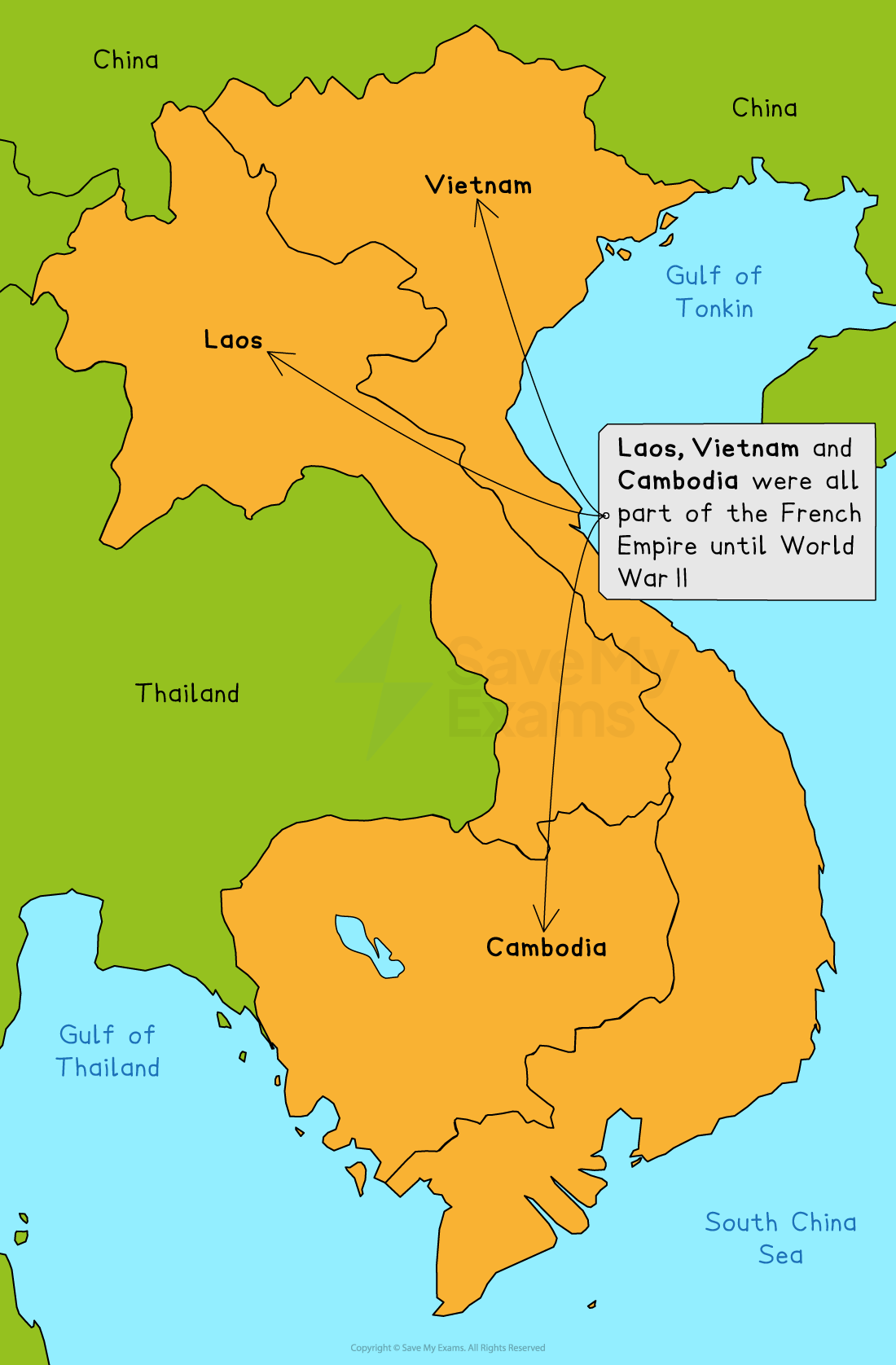Why Did the French Leave Vietnam in 1954? (AQA GCSE History): Revision Note
Exam code: 8145
The French in Vietnam - Summary
At the end of World War II, France attempted to regain control of its former colony of Vietnam. This attempt failed, despite enormous financial support from the USA. With France defeated, the Vietnamese independence leader, Ho Chi Minh, hoped to lead a free and unified country.
Instead, the country was divided into two. The north was governed by communist leader Ho Chi Minh and the south was governed by the anti-communist leader Ngo Dinh Diem.
The government of the north was backed by the USSR and China, whilst the south was supported by the USA. Any conflict between the two Vietnamese governments would lead to the involvement of the two superpowers (USA and USSR).
French rule in Vietnam
From the 18th century until World War II, Vietnam had been part of the French Empire
Along with the modern states of Laos and Cambodia, it formed what became known as French Indochina
France increased its wealth by extracting raw materials such as coal, zinc and rubber from these countries and selling them
The sale of French-manufactured goods in Indochina further increased the wealth of France
During World War II, France was conquered by Nazi Germany and Japan invaded the countries of Indochina
Japan stripped the region of its natural resources and took food to feed its own population
This resulted in nearly 2 million Vietnamese people starving to death
Vietnamese nationalism flourished under the Japanese occupation, and the Vietnamese Independence League (or Vietminh) fought to free the country
The Vietminh was led by two communists, Ho Chi Minh and Nguyen Vo Giap
When Japan surrendered to America at the end of World War II, the Vietminh declared Vietnam to be an independent country and Ho Chi Minh its president
France refused to accept this and was determined to rebuild its empire and economy after the humiliation of World War II
The French sent an army to recapture Vietnam and fought a war against the Vietminh from 1946 to 1954

Dien Bien Phu
Once communists took control of neighbouring China in 1949, they began to supply the Vietminh with weapons and equipment
Vietminh fighters were also trained by experienced Chinese soldiers
The Vietminh waged a guerrilla war against France
They would use hit-and-run tactics and disappear into Vietnam’s vast and dense jungles
The USA became alarmed at China’s involvement in Vietnam and decided to support France in its struggle
Between 1950 and 1954, the USA spent US$3 billion on France’s war with the Vietminh
Over 80% of France’s weaponry and vehicles were supplied by America
Frustrated by the Vietminh’s tactics, in 1954 the French decided to try and force a decisive battle
The plan was to build a fortified base in a remote region that would act as bait and draw the Vietminh out of hiding
Once the Vietminh attacked and exposed themselves, the French planned to use their heavy artillery and air power to destroy them
The French built the fortified base at Dien Bien Phu in northern Vietnam and sent 10,000 troops to protect it
The plan was a disaster for France
The Vietminh destroyed Dien Bien Phu’s runway and completely surrounded the base
This siege meant the troops could not be resupplied with food, water, ammunition or medical supplies
The base was then relentlessly bombarded with Chinese-supplied artillery and rockets
The siege lasted 57 days until the French finally surrendered
Around 3,000 French troops had been killed, and thousands were injured
Many more died as they marched to prisoner-of-war camps after the surrender
The Prime Minister of France resigned after the defeat
France’s Parliament voted overwhelmingly to remove the country's troops from Indochina
The French colonial rule of Vietnam had come to an end
Geneva Agreement, 1954
After the French decision to leave Vietnam, the leaders of the USA, USSR, Britain, France, China and Vietnam all met in the Swiss city of Geneva to decide Vietnam’s future
Vietnam was represented by both Ho Chi Minh and members of the pro-French government that had ruled in the south of the country
Everyone agreed that elections should be held before July 1956 to choose a government for the whole of Vietnam
In the meantime, it was also agreed that Vietnam should be divided along the 17th parallel
The north was to be governed by Ho Chi Minh
The south was to be governed by Ngo Dinh Diem
The Vietnamese people were free to choose to live in North or South Vietnam
Much like in Korea, Vietnam had been divided into two
Just like President Truman was concerned about communism in Korea, President Eisenhower, was concerned that communists were about to take over the whole of Vietnam
In January 1955, American military equipment started to arrive in South Vietnam
The planned elections never occurred
Eisenhower was determined to help support the unpopular Diem and “contain” communism in the north of the country
China and the USSR were determined to support Ho Chi Minh and his Communist government
Vietnam was about to become the next Cold War flashpoint

Examiner Tips and Tricks
Question 2 on this paper will ask you how useful the two sources are. All historical sources are useful in some way, and your task is to identify how and why they are useful — do not just focus on why a source is limited in use or what it doesn’t tell us. Make sure you explain why both sources are useful.

Unlock more, it's free!
Did this page help you?